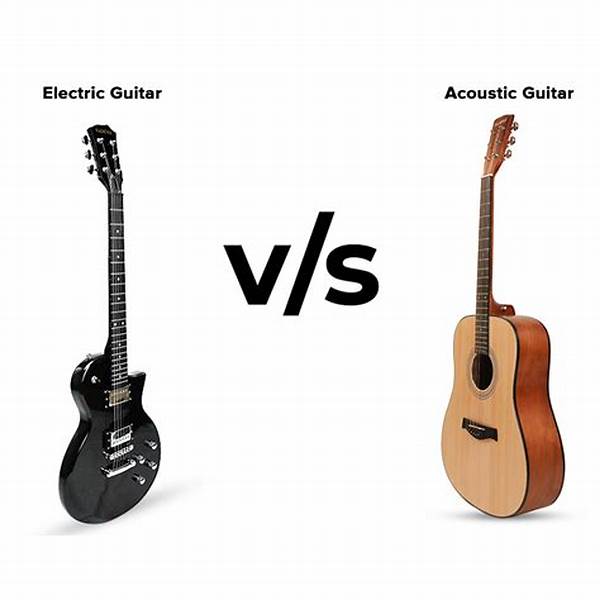Have you ever been mesmerized by the raw energy of a rock concert, watching the lead guitarist shred electrifying riffs? Or maybe you’ve been captivated by the soulful strumming of an acoustic guitar during a cozy campfire gathering? Each guitar type has its own spellbinding charm, capturing hearts with melodies that resonate for a lifetime. If you’re embarking on a quest to strum either an electric or acoustic guitar, it’s crucial to understand their unique differences and decide which one could be your ultimate musical ally.
Read More : Comparison Of Custom-made Vs. Mass-produced Electric Guitars
In this article, we dive into the differences between electric and acoustic guitars. From the profound depths of sound acoustics to the electrifying experience of amplified melodies, we aim to unravel the mysteries that make each guitar unique. Whether you’re a budding musician or a seasoned player, understanding these differences can guide you to the perfect pick that complements your style and aspirations.
Understanding the Differences
The Anatomy of Sound
Let’s begin by tackling the sound anatomy, which is fundamental in identifying the differences between electric and acoustic guitars. Acoustic guitars rely entirely on their hollow bodies to project sound. When you strum the strings, the vibrations resonate through the body, producing a sound that’s rich, warm, and organic. The wood type and body shape significantly influence the tonal qualities.
On the other hand, electric guitars require an amplifier to produce sound. Without the amplifier, strumming an electric guitar feels like whispering secrets. The solid body construction minimizes sound resonance, which, combined with pickups, allows for an amplified, powerful, and versatile sound. Players can explore a myriad of effects through pedals, ranging from distortion to echo, enabling a spectrum of musical creativity.
Playability and Technique
When it comes to playability, the differences between electric and acoustic guitars become distinctly evident. Acoustic guitars typically have thicker necks and heavier strings, demanding more finger strength. This setup can be challenging for beginners but rewarding, as it strengthens finger dexterity and precision.
Electric guitars boast slimmer necks and lighter strings due to their solid bodies and need for amplified sound. This makes them easier to play, especially for fast-paced solos and complex fretboard maneuvers. The action — how high the strings are from the fretboard — is usually lower, facilitating smoother transitions and bends.
Ideal Genres and Settings
Genres are often a telltale sign of the differences between electric and acoustic guitars. Acoustic guitars are synonymous with genres like folk, classical, and unplugged pop. Their ability to produce pure and clean sounds makes them a go-to choice for intimate settings and solo performances.
Conversely, electric guitars dominate genres like rock, blues, metal, and jazz. Their amplified sound complements loud, energetic environments, making them ideal for band settings and electrifying live performances. With the aid of technology, electric guitars offer endless possibilities for sound experimentation, attracting those eager to push musical boundaries.
Exploring the Specifics
Tone Quality
Design and Aesthetics
Maintenance and Accessibility
Key Points to Consider
Cost Factors
Personal Preference
Your decision might ultimately depend on which sound resonates with your personal taste. If the purity and resonance of natural acoustics appeal to you, the acoustic guitar may be your companion of choice. If the flair of electrifying solos and versatility in sound experimentation ignite your passion, the electric guitar could be your soulmate.
Read More : Organ Musical Instrument Tuned For Harmony With Choirs And Orchestras
Performance Requirements
Consider the context in which you’ll use the guitar. If you envisage playing in quiet, intimate settings or value portability without extra equipment, an acoustic guitar offers simplicity and ease. Conversely, if band performances and experimental sounds are your calling, an electric guitar offers that creative edge.
Summary and Conclusion
In exploring the differences between electric and acoustic guitars, we’ve uncovered how their construction, sound projection, and playability define their unique characteristics. Acoustic guitars, with their natural and rich tones, cater to those who appreciate simplicity and purity. They’re ideal for intimate settings and genres that demand clean sound. Electric guitars, introduced in the early 20th century, have revolutionized music with their powerful and dynamic range. With the ability to manipulate sounds through technology, they’re perfect for those eager to explore diverse soundscapes.
These differences influence not just the physical aspects but also the emotional experience and versatility a musician desires. Each guitar tells its own story, and choosing the right one means embarking on a journey that resonates with your musical voice.
Whether your heart lies with the soulful acoustics or the electrifying pulse of electric sounds, understanding these nuances will aid you in selecting the ideal instrument to accompany you on your musical adventures. So, next time you visit a music store or consider strumming your first chord, you’ll be armed with the knowledge to make an informed decision.
Whichever guitar you choose, the world of music awaits your unique touch. Choose wisely and let the music flow, because every great musician starts with understanding the core differences that define their instrument’s soul.
